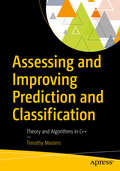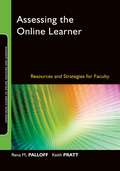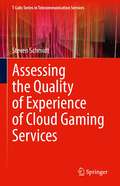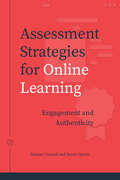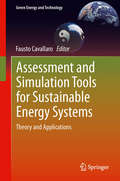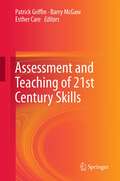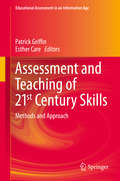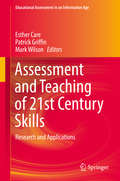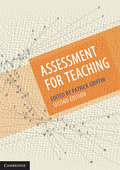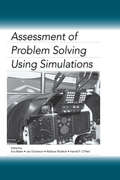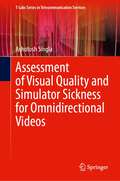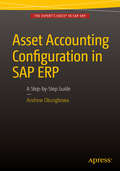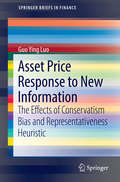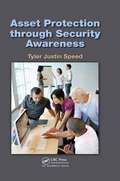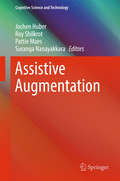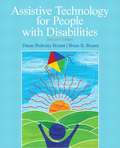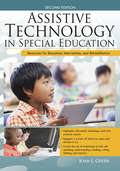- Table View
- List View
Assessing and Improving Prediction and Classification: Theory and Algorithms in C++
by Timothy MastersThis book begins by presenting methods for performing practical, real-life assessment of the performance of prediction and classification models. It then goes on to discuss techniques for improving the performance of such models by intelligent resampling of training/testing data, combining multiple models into sophisticated committees, and making use of exogenous information to dynamically choose modeling methodologies. Rigorous statistical techniques for computing confidence in predictions and decisions receive extensive treatment. Finally, a hundred pages are devoted to the use of information theory in evaluating and selecting useful predictors. Special attention is paid to Schreiber's Information Transfer, a recent generalization of Grainger Causality. Well commented C++ code is given for every algorithm and technique. The ultimate purpose of this text is three-fold. The first goal is to open the eyes of serious developers to some of the hidden pitfalls that lurk in the model development process. The second is to provide broad exposure for some of the most powerful model enhancement algorithms that have emerged from academia in the last two decades, while not bogging down readers in cryptic mathematical theory. Finally, this text should provide the reader with a toolbox of ready-to-use C++ code that can be easily incorporated into his or her existing programs.
Assessing and Insuring Cybersecurity Risk
by Ravi DasRemote workforces using VPNs, cloud-based infrastructure and critical systems, and a proliferation in phishing attacks and fraudulent websites are all raising the level of risk for every company. It all comes down to just one thing that is at stake: how to gauge a company’s level of cyber risk and the tolerance level for this risk. Loosely put, this translates to how much uncertainty an organization can tolerate before it starts to negatively affect mission critical flows and business processes. Trying to gauge this can be a huge and nebulous task for any IT security team to accomplish. Making this task so difficult are the many frameworks and models that can be utilized. It is very confusing to know which one to utilize in order to achieve a high level of security. Complicating this situation further is that both quantitative and qualitative variables must be considered and deployed into a cyber risk model. Assessing and Insuring Cybersecurity Risk provides an insight into how to gauge an organization’s particular level of cyber risk, and what would be deemed appropriate for the organization’s risk tolerance. In addition to computing the level of cyber risk, an IT security team has to determine the appropriate controls that are needed to mitigate cyber risk. Also to be considered are the standards and best practices that the IT security team has to implement for complying with such regulations and mandates as CCPA, GDPR, and the HIPAA. To help a security team to comprehensively assess an organization’s cyber risk level and how to insure against it, the book covers: The mechanics of cyber risk Risk controls that need to be put into place The issues and benefits of cybersecurity risk insurance policies GDPR, CCPA, and the the CMMC Gauging how much cyber risk and uncertainty an organization can tolerate is a complex and complicated task, and this book helps to make it more understandable and manageable.
Assessing and Managing Security Risk in IT Systems: A Structured Methodology
by John McCumberThis book begins with an overview of information systems security, offering the basic underpinnings of information security and concluding with an analysis of risk management. Part II describes the McCumber Cube, providing the original paper from 1991 and detailing ways to accurately map information flow in computer and telecom systems. It also explains how to apply the methodology to individual system components and subsystems. Part III serves as a resource for analysts and security practitioners who want access to more detailed information on technical vulnerabilities and risk assessment analytics. McCumber details how information extracted from this resource can be applied to his assessment processes.
Assessing the Online Learner
by Keith Pratt Rena M. PalloffWritten by Rena M. Palloff and Keith Pratt, experts in the field of online teaching and learning, this hands-on resource helps higher education professionals understand the fundamentals of effective online assessment. It offers guidance for designing and implementing creative assessment practices tied directly to course activities to measure student learning. The book is filled with illustrative case studies, authentic assessments based in real-life application of concepts, and collaborative activities that assess the quality of student learning rather than relying on the traditional methods of measuring the amount of information retained.
Assessing the Quality of Experience of Cloud Gaming Services (T-Labs Series in Telecommunication Services)
by Steven SchmidtThis book provides an overview of concepts and challenges in intis investigated using structural equation modeling. The conveyed understanding of gaming QoE, empirical eraction quality in the domain of cloud gaming services. The author presents a unified evaluation approach by combining quantitative subjective assessment methods in a concise way. The author discusses a measurement tool, Gaming Input Quality Scale (GIPS), that assesses the interaction quality of such a service available. Furthermore, the author discusses a new framework to assess gaming Quality of Experience (QoE) using a crowdsourcing approach. Lastly, based on a large dataset including dominant network and encoding conditions, the evaluation method is investigated using structural equation modeling. The conveyed understanding of gaming QoE, empirical findings, and models presented in this book should be of particular interest to researchers working in the fields of quality and usability engineering, as well as service providers and network operators.
Assessment for Teaching
by Patrick GriffinAssessment for Teaching is a comprehensive and practical introduction to assessment and learning in primary and secondary school settings. This book treats assessment as a source of data that informs teaching strategies. It replaces a deficit model of assessment with a development model: a framework which recognises the importance of identifying what the student is ready to learn. The book also promotes collaboration between teachers in professional learning teams - encouraging the sharing of assessment data and team-based interpretation - to improve student outcomes and to plan goals for students based on a development scale. Each chapter contains: - an exercise for applying the course content to classroom practice - a response template for the exercise - guidelines on assessing the value of the exercise in a professional learning team - a short test for participants to cross-check their understanding of the course content This is an essential resource for both pre-service and in-service teachers.
Assessment Strategies for Online Learning: Engagement and Authenticity (Issues in Distance Education)
by Dianne Conrad Jason OpenoFor many learners assessment conjures up visions of red pens scrawling percentages in the top right-hand corner of exams and feelings of stress, inadequacy, and failure. Although negative student reactions to evaluation have been noted, assessment has provided educational institutions with important information about learning outcomes and the quality of education for many decades. But how accurate is this data and has it informed practice or been fully incorporated into the learning cycle? Conrad and Open argue that the potential in many of the new learning environments to alter and improve assesment has yet to be explored by educators and students. In their investigation of assessment methods and learning approaches, Conrad and Openo aim to explore assessment that engages learners and authentically evaluates education. They insist that moving to new learning environments, specifically those online and at a distance, afford educators opportunities to embrace only the most effective face-to-face assessment methods and to realize the potential of delivering education in the digital age. In this volume practitioners will find not only an indispensable introduction to new forms of assessment but also a number of best practices as described by experienced educators.
Assessment and Simulation Tools for Sustainable Energy Systems: Theory and Applications (Green Energy and Technology #129)
by Fausto CavallaroIn recent years, the concept of energy has been revised and a new model based on the principle of sustainability has become more and more pervasive. The appraisal of energy technologies and projects is complex and uncertain as the related decision making has to encompass environmental, technical, economic and social factors and information sources. The scientific procedure of assessment has a vital role as it can supply the right tools to evaluate the actual situation and make realistic forecasts of the effects and outcomes of any actions undertaken. Assessment and Simulation Tools for Sustainable Energy Systems offers reviews of the main assessment and simulation methods used for effective energy assessment. Divided across three sections, Assessment and Simulation Tools for Sustainable Energy Systems develops the reader's ability to select suitable tools to support decision making and implementation of sustainable energy projects. The first is dedicated to the analysis of theoretical foundations and applications of multi-criteria decision making. This is followed by chapters concentrating on the theory and practice of fuzzy inference, neural nets and algorithms genetics. Finally, simulation methods such as Monte Carlo analysis, mathematical programming and others are detailed. This comprehensive illustration of these tools and their application makes Assessment and Simulation Tools for Sustainable Energy Systems a key guide for researchers, scientists, managers, politicians and industry professionals developing the field of sustainable energy systems. It may also prompt further advancements in soft computing and simulation issues for students and researchers.
Assessment and Teaching of 21st Century Skills: Methods And Approach (Educational Assessment in an Information Age)
by Patrick Griffin Barry Mcgaw Esther CareRapid--and seemingly accelerating--changes in the economies of developed nations are having a proportional effect on the skill sets required of workers in many new jobs. Work environments are often technology-heavy, while problems are frequently ill-defined and tackled by multidisciplinary teams. This book contains insights based on research conducted as part of a major international project supported by Cisco, Intel and Microsoft. It faces these new working environments head-on, delineating new ways of thinking about '21st-century' skills and including operational definitions of those skills. The authors focus too on fresh approaches to educational assessment, and present methodological and technological solutions to the barriers that hinder ICT-based assessments of these skills, whether in large-scale surveys or classrooms. Equally committed to defining its terms and providing practical solutions, and including international perspectives and comparative evaluations of assessment methodology and policy, this volume tackles an issue at the top of most educationalists' agendas.
Assessment and Teaching of 21st Century Skills: Methods and Approach (Educational Assessment in an Information Age)
by Patrick Griffin Esther CareThis second volume of papers from the ATC21STM project deals with the development of an assessment and teaching system of 21st century skills. Readers are guided through a detailed description of the methods used in this process. The first volume was published by Springer in 2012 (Griffin, P. , McGaw, B. & Care, E. , Eds. , Assessment and Teaching of 21st Century Skills, Dordrecht: Springer). The major elements of this new volume are the identification and description of two 21st century skills that are amenable to teaching and learning: collaborative problem solving, and learning in digital networks. Features of the skills that need to be mirrored in their assessment are identified so that they can be reflected in assessment tasks. The tasks are formulated so that reporting of student performance can guide implementation in the classroom for use in teaching and learning. How simple tasks can act as platforms for development of 21st century skills is demonstrated, with the concurrent technical infrastructure required for its support. How countries with different languages and cultures participated and contributed to the development process is described. The psychometric qualities of the online tasks developed are reported, in the context of the robustness of the automated scoring processes. Finally, technical and educational issues to be resolved in global projects of this nature are outlined.
Assessment and Teaching of 21st Century Skills: Research and Applications (Educational Assessment in an Information Age)
by Mark Wilson Patrick Griffin Esther CareRapid--and seemingly accelerating--changes in the economies of developed nations are having a proportional effect on the skill sets required of workers in many new jobs. Work environments are often technology-heavy, while problems are frequently ill-defined and tackled by multidisciplinary teams. This book contains insights based on research conducted as part of a major international project supported by Cisco, Intel and Microsoft. It faces these new working environments head-on, delineating new ways of thinking about '21st-century' skills and including operational definitions of those skills. The authors focus too on fresh approaches to educational assessment, and present methodological and technological solutions to the barriers that hinder ICT-based assessments of these skills, whether in large-scale surveys or classrooms. Equally committed to defining its terms and providing practical solutions, and including international perspectives and comparative evaluations of assessment methodology and policy, this volume tackles an issue at the top of most educationalists' agendas.
Assessment for Teaching
by Patrick GriffinAssessment for Teaching is a comprehensive and practical introduction to assessment and learning in primary and secondary school settings. This book treats assessment as a source of data that informs teaching strategies. It replaces a deficit model of assessment with a development model: a framework which recognises the importance of identifying what the student is ready to learn. The book also promotes collaboration between teachers in professional learning teams - encouraging the sharing of assessment data and team-based interpretation - to improve student outcomes and to plan goals for students based on a development scale. Each chapter contains: * an exercise for applying the course content to classroom practice * a response template for the exercise * guidelines on assessing the value of the exercise in a professional learning team * a short test for participants to cross-check their understanding of the course content. This is an essential resource for both pre-service and in-service teachers.
Assessment in Game-Based Learning: Foundations, Innovations, and Perspectives (Advances In Game-based Learning Ser.)
by Dirk Ifenthaler Xun Ge Deniz EseryelThe capabilities and possibilities of emerging game-based learning technologies bring about a new perspective of learning and instruction. This, in turn, necessitates alternative ways to assess the kinds of learning that is taking place in the virtual worlds or informal settings. accordingly, aligning learning and assessment is the core for creating a favorable and effective learning environment. The edited volume will cover the current state of research, methodology, assessment, and technology of game-based learning. There will be contributions from international distinguished researchers which will present innovative work in the areas of educational psychology, educational diagnostics, educational technology, and learning sciences. The edited volume will be divided into four major parts.
Assessment of Online Learners: Foundations and Applications for Teacher Education
by Paolina Seitz S. Laurie HillAssessment of Online Learners offers essential foundations, insights, and real-world examples for preservice teachers preparing to assess students in today’s digitized classrooms. When aligned with intended curricula and best practices, assessment not only informs but enhances both instruction and student achievement, though the recent large-scale adaptation of face-to-face learning to online platforms has yielded new challenges and responsibilities for teachers. This book explores shifts in the research and practice of assessment in online environments, the reconceptualization of course content and assessment frameworks in teacher education, the collection of fair and accurate assessment evidence reflecting students’ virtual learning, and more. Drawing from experienced Canadian instructors who overcame the inherent technological obstacles, these chapters showcase how unprecedented changes in schooling can lead to pedagogical renewal, program reevaluation, and a broader understanding of instruction and assessment practices.
Assessment of Online Learners: Foundations and Applications for Teacher Education
by Paolina Seitz S. Laurie HillAssessment of Online Learners offers essential foundations, insights, and real-world examples for preservice teachers preparing to assess students in today’s digitized classrooms. When aligned with intended curricula and best practices, assessment not only informs but enhances both instruction and student achievement, though the recent large-scale adaptation of face-to-face learning to online platforms has yielded new challenges and responsibilities for teachers. This book explores shifts in the research and practice of assessment in online environments, the reconceptualization of course content and assessment frameworks in teacher education, the collection of fair and accurate assessment evidence reflecting students’ virtual learning, and more. Drawing from experienced Canadian instructors who overcame the inherent technological obstacles, these chapters showcase how unprecedented changes in schooling can lead to pedagogical renewal, program reevaluation, and a broader understanding of instruction and assessment practices.
Assessment of Problem Solving Using Simulations
by Eva Baker Jan Dickieson Wallace Wulfeck Harold F. O’NeilThis volume explores the application of computer simulation technology to measurement issues in education -- especially as it pertains to problem based learning. Whereas most assessments related to problem solving are based on expensive and time consuming measures (i.e., think-aloud protocols or performance assessments that require extensive human rater scoring), this book relies on computerization of the major portion of the administration, scoring, and reporting of problem-solving assessments. It is appropriate for researchers, instructors and graduate students in educational assessment, educational technology, and educational psychology.
Assessment of Visual Quality and Simulator Sickness for Omnidirectional Videos (T-Labs Series in Telecommunication Services)
by Ashutosh SinglaThis book presents extensive research on the quality of 360° video perceived by users with HMDs. The book aims to develop a set of standard guidelines for the systematic visual quality assessment of 360° videos. Firstly, conventional subjective test methods such as Absolute Category Rating (ACR) and Double Stimulus Impairment Scale (DSIS) are applied to evaluate video quality, alongside the Modified ACR (M-ACR) method newly proposed. Building on the reliability and general applicability of the procedure across different tests, a methodological framework for 360° video quality assessment is then presented. The author also analyzes simulator sickness to investigate the impact of different influencing factors. The insights gained on simulator sickness related to 360° video contribute to a better understanding of this particular use case of VR and can help to improve comfort among users by suggesting improvements in the technical specifications of 360° video and HMD technology and thus improving QoE.
Asset Accounting Configuration in SAP ERP: A Step-by-Step Guide
by Andrew OkungbowaIn this book, noted expert Andrew Okungbowa explains SAP Asset Accounting (FI-AA) in SAP-ERP, including its associated business benefits, and guides you through the considerable complexities of SAP-ERP configuration. Using FI-AA for fixed asset management enables you to manage assets in multinational companies across a broad range of industries and produce reports to meet various needs in line with legal requirements. Configuring SAP-ERP can be a daunting exercise, however, and there are few resources that address these issues. Asset Accounting Configuration in SAP ERP fills that resource gap by covering the major aspects of SAP FI-AA for anyone with SAP experience and the basic accounting knowledge and bookkeeping skills necessary to apply configuration. It provides configuration explanations in the simplest forms possible and provides step-by-step guidance with illustrations and practical examples. What you'll learn The details of the FI-AA syllabus How to configure FI-AA accounting in SAP How to integrate FI-AA accounting with other SAP modules How to transfer asset data How to prepare for startup and perform periodic processing Who this book is for The key target audience for this book includes SAP consultants, developers, accountants, support organizations and beginners. It is also a resourceful learning manual for universities and institutions whose curricula covers SAP-ERP Asset Accounting. Table of Contents Chapter 1 - Customizing Organizational Structures in SAP Asset Accounting (FI-AA) Chapter 2 - Integrating Asset Accounting with the General Ledger (FI-GL) Chapter 3 - Valuation of Fixed Assets Chapter 4 - Depreciation Chapter 5 - Special Valuation Chapter 6 - Customizing Master Data Chapter 7 - Customizing Transactions Chapter 8 - Customizing Validation and Substitution Chapter 9 - Reporting with Asset Accounting Chapter 10 - Transferring Asset Data Chapter 11 - Preparing for Production Startup Chapter 12 - Processing Periodic Programs Appendix A - Useful General Ledger Accounts Appendix B - Useful Transaction Codes
Asset Attack Vectors: Building Effective Vulnerability Management Strategies to Protect Organizations
by Morey J. Haber Brad HibbertBuild an effective vulnerability management strategy to protect your organization’s assets, applications, and data.Today’s network environments are dynamic, requiring multiple defenses to mitigate vulnerabilities and stop data breaches. In the modern enterprise, everything connected to the network is a target. Attack surfaces are rapidly expanding to include not only traditional servers and desktops, but also routers, printers, cameras, and other IOT devices. It doesn’t matter whether an organization uses LAN, WAN, wireless, or even a modern PAN—savvy criminals have more potential entry points than ever before. To stay ahead of these threats, IT and security leaders must be aware of exposures and understand their potential impact. Asset Attack Vectors will help you build a vulnerability management program designed to work in the modern threat environment. Drawing on years of combined experience, the authors detail the latest techniques for threat analysis, risk measurement, and regulatory reporting. They also outline practical service level agreements (SLAs) for vulnerability management and patch management. Vulnerability management needs to be more than a compliance check box; it should be the foundation of your organization’s cybersecurity strategy. Read Asset Attack Vectors to get ahead of threats and protect your organization with an effective asset protection strategy. What You’ll Learn Create comprehensive assessment and risk identification policies and procedures Implement a complete vulnerability management workflow in nine easy steps Understand the implications of active, dormant, and carrier vulnerability states Develop, deploy, and maintain custom and commercial vulnerability management programs Discover the best strategies for vulnerability remediation, mitigation, and removal Automate credentialed scans that leverage least-privilege access principles Read real-world case studies that share successful strategies and reveal potential pitfalls Who This Book Is For New and intermediate security management professionals, auditors, and information technology staff looking to build an effective vulnerability management program and defend against asset based cyberattacks
Asset Price Response to New Information: The Effects of Conservatism Bias and Representativeness Heuristic (SpringerBriefs in Finance)
by Guo Ying LuoAsset Price Response to New Information examines the effect of two types of psychological biases (namely, conservatism bias and representativeness heuristic) on the asset price reaction to new information. The author constructs various models of a competitive securities market or a security market allowing for strategic interaction among traders to prove rigorously that either conservatism or representativeness is capable of generating both asset price overreaction and underreaction to new information. The results shed some new insights on the phenomena of the asset price overreaction and underreaction to new information. In the literature, very little has been published in this area of behavioral finance. This volume will appeal to graduate-level students and researchers in finance, behavioral finance, and financial engineering.
Asset Protection through Security Awareness: Theory, Methods, And Applications (Systems Innovation Book Ser.)
by Tyler Justin SpeedSupplying a high-level overview of how to protect your company's physical and intangible assets, Asset Protection through Security Awareness explains the best ways to enlist the assistance of your employees as the first line of defense in safeguarding company assets and mitigating security risks. The author reviews key topics surrounding computer s
Assistive Augmentation (Cognitive Science and Technology)
by Jochen Huber Roy Shilkrot Pattie Maes Suranga NanayakkaraThis book addresses Assistive Augmentation, highlighting the design and development of assistive technologies, user interfaces, and interactions that seamlessly integrate with a user's mind, body, and behavior, providing an enhanced perception. Our senses are the dominant channel we use to perceive the world around us. Whether they have impairments or not, people often find themselves at the limits of their sensorial capabilities. Some seek assistive or enhancing devices that enable them to carry out specific tasks or even transform them into a "superhuman" with capabilities well beyond the ordinary. The overarching topic of this book revolves around the design and development of technologies and interfaces that provide enhanced physical, sensorial and cognitive capabilities: "Assistive Augmentation". The Assistive Augmentation community convened at an interdisciplinary workshop at the 2014 International Conference on Human Factors in Computing Systems (CHI) in Toronto, Canada. The community is comprised of researchers and practitioners who work at the junction of human-computer interaction, assistive technology and human augmentation. This edited volume, which represents the first tangible outcome of the workshop, presents stimulating discussions on the challenges of Assistive Augmentation as examined through case studies. These studies focus on two main areas: (1) Augmented Sensors and Feedback Modalities, and (2) Design for Assistive Augmentation.
Assistive Technology For Children And Youth With Disabilities
by Mary Ann Marchel Denise M. Clark Thomas A. FischerEncompassing home, school and community environments, Assistive Technology for Children and Youth with Disabilities highlights the vast amount of supports available for children with disabilities from birth to age 21. An informative resource, the text details not only what types of assistive technology exist, but also how to select technology to meet specific students needs and match specific environmental circumstances. Chapters address the broad range of technologies now available, including supports for mobility, positioning, access, academic areas, behavior problems, recreation, and transitioning. Case examples, vignettes and activities provide practical, real-life examples that show how to use assistive technology to improve the independence and participation of students with special needs.
Assistive Technology For People With Disabilities (Second Edition)
by Diane Pedrotty Bryant Brian R. BryantAssistive Technology for People with Disabilities, Second Edition, includes eight comprehensive chapters that focus on devices and software to enhance the lives and promote the independence of people with disabilities. Updated with new research, content and features to address current developments in the field, the book approaches assistive technology and education in a lifespan, multidisciplinary manner by discussing the use of current technology in the fields of special education, rehabilitation, speech-language pathology, and other disciplines. Featured devices and software will help you understand how areas such as mobility, communication, education, independent living, and access to information media affect learning and living for individuals with disabilities. You will also gain a great understanding of the foundational and historical perspectives of AT, assessment, universal design, and the ADAPT framework, which is a tool to help educators make decisions about appropriate AT, student needs, and the demands of the environment. Developed from the authors' years of experience teaching both K-12 students and adults, as well as their own framework for understanding assistive technology application and integrating technology into instruction, this new edition addresses assistive technology that promotes knowledge and skills, practical application and a myriad of opportunities that good technology provides for persons with disabilities.
Assistive Technology In Special Education: Resources for Education, Intervention, and Rehabilitation (Second Edition)
by Joan GreenFamilies, teachers, and therapists who are searching for an update about how to use the latest technologies to help individuals who struggle with communication, literacy, and learning will benefit from the wealth of practical, well-organized information in this second edition of Assistive Technology in Special Education. The indexed update presents an overview of the uses of technologies to help readers zero in on specific, powerful, cutting-edge resources they can use to enhance success. The book features new tools to improve and compensate for challenges relating to speaking, understanding, reading, writing, thinking and remembering, as well as strategies to help students become more organized and efficient. The use of tablets such as the iPad and smartphones, as well as cloud-based products, are highlighted. Online resources and social networking tools are presented to empower readers to learn about new products as they become available.
